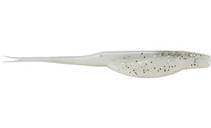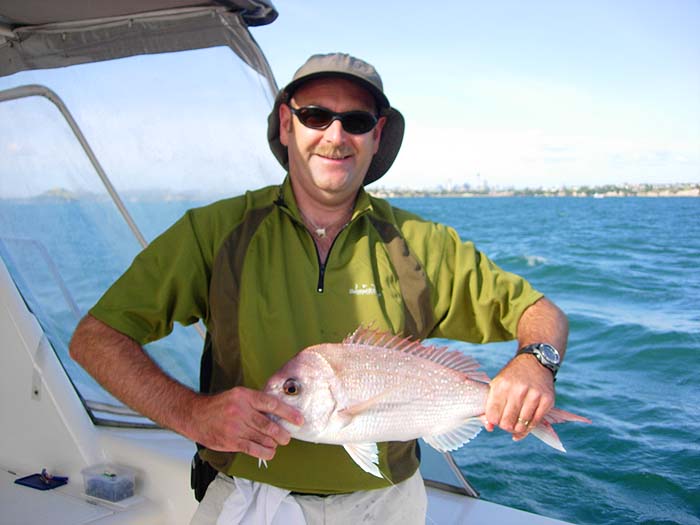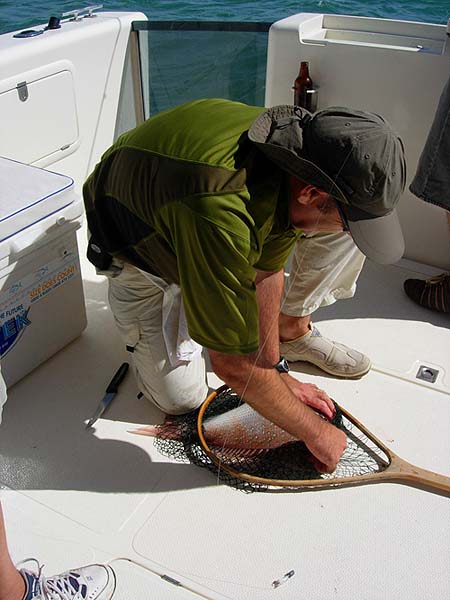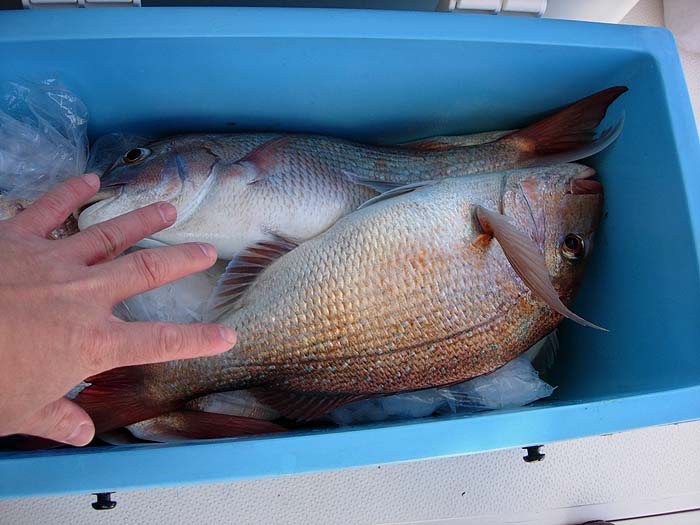 '
'Information Page.
Rangitoto.
Alan Bulmer has been doing a few more tests with soft plastic baits for snapper and the results are fascinating.
Hi Mike,
Just a quick note to tell you I went out boat fishing today. 6 anglers on board landed and kept 30 fish. I fished soft baits exclusively again and kept 8 Snapper. The smallest was 3 lb and the largest a thumping 7.5 lb fish. Three other fish were caught on SP’s and the balance on bait. The largest bait caught fish was 5.5 lb. The bait fishermen caught heaps of small fry. I will write a proper report in due course.
Best regards,
Alan Bulmer
I replied with a few queries about the behaviour of snapper, thinking that they probably resembled black bream in some respects. I also (tongue in cheek) suggested that if he was under the illusion that he'd 'cracked it' next time he tried the fish might be less cooperative (they always are for me). Again Alan's reply was a mine of information.
Hi Mike,
Snapper move into the Hauraki Gulf to spawn in spring (October – November). Spawning only occurs when the water temperature reaches 18degrees C. After spawning the fish hang around and feed ravenously to regain condition. The big fish we have been catching are mostly spent males, however all have recovered from the rigours of spawning and are in excellent condition. They should hang around for another month or so and then leave en masse in autumn (May). Some fish (especially the large ones) will hang around all winter and feed steadily. There must be a huge biomass of Snapper in the inner harbour channels at the moment as we were picking them up everywhere today. The Hauraki Gulf is purported to be the largest Snapper spawning ground in NZ. Fancy, we spent all of today within 2 kilometres of the Auckland city centre. Where else in the world can you experience fishing like that?
I have no doubt that I have not 'cracked it' with snapper. A mixture of skill, timing and luck are playing a part. Fishing with SP’s is awesome fun as the snapper savage the lure and the first run is electric on light tackle. Peter knows now that if I hook up and the drag is howling then he needs to get the net as the drag is set at 3 lb and fish less than 4 lb do not pull string!
Best regards,
Alan Bulmer
I commented again on the similarities between snapper behaviour and that of our own black bream and with growing jealousy I awaited Alan's next email. I was not disappointed.
Hi Mike,
I agree that there seem to be a lot of similarities between black bream and snapper. The male snapper do apparently arrive first and in the early season it is not uncommon to catch large fish (up to 15 kilograms). Imagine connecting to one of the big fish on SP tackle! 200 metres of 8lb braid would all of a sudden seem woefully inadequate.
The NZ snapper fishery is recovering from a period where the regulatory authorities set the quota to high so it is prudent to limit the kill. My view is that 9 fish per person is still too high and the size limit should be increased to 35 cm. We could have taken 54 legally yesterday (landed at least that many fish over 27 cm.) and 30 kept was way too high. Peter has brought in all of the fillets, that were not taken by the anglers and crew, to work today for the staff that did not go out on the boat. As you know most of what I catch normally goes straight back after a photograph. I only took the large fish (to show the family) and one other of about 4 lb. home. We had it for dinner – delicious. Sandy is a tad miffed as she was the “large snapper specialist” in the family and now she believes that her reputation has been tarnished slightly over the last week. I will have to take the family out in our boat over the weekend to give her a chance to redeem herself.
Many thanks and best regards
Alan Bulmer
--- and then he sent the full story.
Hi Mike,
I though you may be interested in a detailed account of our trip on Thursday.
The day dawned clear with concrete grey clouds gathering ominously on the horizon. A red glow silhouetted the clouds which was an ugly portent. The weather forecast signalled the approach of a low pressure system and the wind was predicted to jump from a benign 10 – 15 knot NW to a vigorous 25 knot NW by the end of the afternoon. Our departure from the Orakei marina coincided with dead low tide so the Skipper decided it prudent to escape the worst of the breeze and anchor close to one of the Rangitoto channel marker buoys. This would allow us to fish the outgoing tide at anchor untroubled by too much wave slop.
There were 5 anglers on board and it was decided that 3 should fish bait (Pilchards) and the other two should fish soft plastics. Stuart and I had both recently purchased soft plastic lures from USA and opted to fish these from the outset. I selected a Zoom Super Fluke Junior in White Ice and threaded it onto a ½ oz. jighead (see below) while Stuart opted for a Pearl/Black Sassy shad. I had opted to take out my Okuma X-Factor Dropshot rod (rated 6 – 10 kilogram) and Salina 30 reel spooled with 8 lb. breaking strain Fireline. Attached to the fused braid was an 8’ length of clear 15 lb. Amnesia. The drag was set at 3 lb. which is almost heavy enough to cut hands when line is pulled from the spool manually.
First blood went to the “bait soakers” who hooked up almost as soon as their bait touched down on the bottom. The action was fairly consistent with a steady procession of undersize Snapper making a brief appearance in the net. None of the fish landed were legal, just small juvenile Snapper. Stuart and I were having touches but could not hook up as the fish seemed reluctant to engulf the soft baits. After 30 minutes, with nothing in the fish bin to show for our efforts, the Skipper announced his intention to move and try our luck drifting. He motored closer to Rangitoto Island cut the throttle slowly and told us to start fishing. The combination of steady NE wind and outgoing tide culminated in a predictable NNW drift which was ideal for both bait and soft bait angling. The water was around 12 metres deep and the seabed throughout the drift consisted largely of mud and broken shell interspersed with clumps of rock, weed and marine worm beds.
I lobbed my lure about 20 metres upstream from the boat, clicked over the bail arm and took care to keep the line tight as the boat drifted steadily towards the lure. Every tap and scrape of the lure was being transmitted up the line and the 2 mm. thick tip of the rod was nodding happily. Slowly the line and boat converged. I gave the lure a small twitch just before I started to retrieve and a fish absolutely monstered the lure. Line streamed off the reel as the fish headed off under the boat. The rod loaded up into a fighting curve as the weight came on and the tip was driven under the water. The fish took about 50 metres of line and started shaking its head. It was a Snapper and felt solid. I had no option but to work my way around the stern and get tight on the fish. I negotiated one angler and was passing the second when almost on cue it took off again, wrenching more line of the spool as it did so. Keeping the rod and line away from the other angling paraphernalia was proving challenging, especially as I was pulled unceremoniously past the bait board. Eventually I got around to the side nearest the fish and slowly began to pump the rod to regain line but it was a slow process. Two steps forward and one step back! The Snapper fought strongly and when it was not pulling line it shook its head like a dog fighting over a rope. It took about 5 minutes to gain ascendancy and another 5 minutes to wrestle the fish to the surface and the waiting net. In the net the Snapper weighed 6 lbs. and, at 50 cm. long, was a great way to start the session.
By now we had almost drifted into the main shipping lane so the Skipper started the engines and used his GPS to retrace our path back to the start of the previous drift. Everyone was champing at the bit to get into the fish and lines plummeted into the depths almost as soon as the boat came to a halt. Unlike the others, I waited for the boat to settle before lobbing the battered lure upstream. Clicking the bail and removing the slack as soon as it touched down. The lure descended quickly but this time it was hammered mid water by another large Snapper. Again line poured off the reel against the heavy drag setting and I called for the net. Nobody could believe it. Two casts, two decent Snapper hooked. Unlike the previous fish this one fought hard on my side of the boat and, as it was pulling line away from me, was much easier to control. It took line in several determined bursts but slowly the drag and relentless rod pressure took toll. After 5 minutes of aerobic workout the fish slid gently into the net. It was almost identical in dimensions to the first.
Remarkably the lure was still usable, although festooned with tears and teeth marks, so I lobbed it into the water upstream again. It sank to the bottom and bounced back towards the boat. Every couple of seconds there was an uncharacteristic bump and I knew that it was only a matter of time before the lure got spanked again. When the thump came I was ready for it and struck back firmly. Again it was a Snapper and the whirring spool betrayed its size. It felt slightly bigger and after 5 minutes I had made little progress as it was using the current to best advantage. By now my arms were starting to ache from the relentless pressure. It made another searing run, then started to tire and after another 5 minutes was brought boat side for netting. It was a mirror image of the other two fish but had missed the lure and was foul hooked just behind the head which explained the difficulty in gaining ascendancy.
To cut a long story short, we drifted once more on this route and I landed another large Snapper. Remarkably no one else had hooked up and everyone by this stage had switched to soft plastic. Others had obviously been watching our progress and two boats moved into our drift lane and anchored hoping to share in the success. This prompted the Skipper to move slightly further inshore and try a parallel drift. I opted to prepare an Antipasto platter (Proscuitto, Salami, Chorizo, Fetta, Smoked Chilli mussels, warm Turkish bread, chunky dips and Olives) for the team at this point and rest my arms.
While I was on food preparation duty, a few of the other anglers had bites on soft plastic but could not hook up. Many of the lures, especially the CATCH brand (Grant Bittle of “Is smell important” fame), came back to the boat tail less and I put this down to the fact that the anglers were not keeping the line tight and striking hard at every touch.
I returned to the fray late in the drift and hooked up again on the second cast. I had changed lure to a larger Zoom Super Fluke (Smokin’ shad colour) and again the fish was respectable and gave an excellent account of itself.
None of the other anglers was able to gain mastery with soft plastics and slowly one by one the anglers reverted to bait. They started to land the odd fish but only caught one large Snapper around 6 lbs. all day. Interestingly only one other angler landed a fish on a soft plastic and this was when he left the lure down as the Skipper engaged the motors to return to the start of a drift. We continued to drift fish for around 3 hours and caught 22 in total. I landed 12 – 14 and my 4 largest fish all were 6 lbs. Nothing was smaller than 3 lbs.
I was the only angler using high visibility braid (the others all used Smoke) and I believe that because I could see the line it made it easier to keep it tight. The key seemed to be to keep in touch with the lure at all times and give the occasional small twitch and draw to stimulate interest. I did try a Berkley PowerBait jerkbait and caught a smaller Snapper. All of the big fish came on the Zoom lures which are very pliable and have a very realistic action.
Must go as I am being called to dinner!
Very best regards,
Alan Bulmer
About a week later Alan had another trip.
Hi Mike,
As promised, please find below an account of my Thursday trip out in the Hauraki Gulf.
Despite the prediction of bad weather from the forecasters, the day dawned bright and warm with a few wisps of cloud smudging the otherwise clear blue sky. Low tide was schedule for 7.00 am so we agreed to meet the clients at the marina early with the aim of being out on the harbour fishing by 8.00 am. As we cleared the marina entrance the harbour was an oily, glassy calm with a very faint breeze puffing weakly from the NE. Conditions were perfect and all the signs were that the day was going to be a scorcher.
Surveying the conditions Peter, the skipper, decided to head out to fish on the edge of the Rangitoto shipping channel. He pointed the bow of the launch towards Rangitoto lighthouse and motored steadily out to the channel edge. Here he throttled back and carefully searched the margins for sign using the fish finder. It did not take long to find a patch of fish hanging around some foul bottom about 250 metres upstream of a buoy. The anchor was dropped and before the incoming current had time to stretch the anchor chain taut the anglers had deployed pilchard baits to the bottom. I decided to fish again solely with soft plastic baits and slid a Zoom White Ice (Junior) onto a ½ oz. jighead before proceeding up the side of the boat to the foredeck. I figured that it would be hard to fish the soft plastic properly from the stern without interfering with the bait fisherman and that if I was alone on the foredeck it would be possible to cast upstream and walk the plastic back to the stern slowly on a tight line, optimising my chances of success.
Peter caught the first snapper on his first drop and it was a cracking 5 ½ lb. fish which apparently gave him a solid workout on his conventional tackle. Everyone was under instructions to keep quiet so that I would be unaware of this capture. He carefully landed the fish; “iki” spiked it, slid it into the fish bin and covered with a bag of ice. There was no way Peter was going to be outdone by soft plastics today. He was determined to land the biggest fish and present it with a flourish later! The bait fishermen were all soon fast into fish (running rigs were doing better than ledger rigs until the current gathered momentum) and within 15 minutes had covered the large Snapper with several smaller 35 cm. specimens.
It was hard work up on the foredeck. I was getting reasonable drifts, could feel the bites but was unable to hook up. This brought much delight to my colleagues at the stern who were continuously passing comments as to the effectiveness of ribbed rubber. Eventually after about 40 minutes I switched to the shady side of the launch and got slammed amidships on the first drift. This was much better. The Snapper tore line off against 3 lb of drag so was obviously bigger than most of what had been landed to date. It was not a huge fish though so after a short period of head shaking and short runs it relented and was worked slowly to the surface. I quickly brought the 3 ½ lb fish to the side of the boat and carefully walked it down to the stern for netting. You could hear the lips zipping! Any thoughts that the soft plastic was going to come good were quickly dashed however and I spent another 45 minutes striking at thin air, unable to hook up again. The fishing also slowed for the bait fisherman so Peter decided to up anchor and drift slowly with the incoming tide.
He started the boat up and motored to the same spot as we had started from the previous week. While in transit we rustled up morning tea which consisted of steaming mugs of tea and coffee accompanied by freshly toasted, buttered Hot Cross Buns. When the boat engines were cut our drift was in a SW direction as tide was stronger than breeze (unlike the previous week when it was NW). The drift direction seemed to make no difference as the Zoom soft bait was absolutely monstered as soon as it touched the bottom on the first drop. Instead of casting ahead of the boat and retrieving slack line to keep tight as the boat drifted towards the lure, I chose to drop the lure directly down the side and allow it to effectively drag behind the boat in a controlled manner. As soon as the line tightened I quickly clicked over the bail arm and line was immediately wrenched from the spool as a feisty Snapper sought its freedom. It pulled away from the boat on a strong initial run but soon tired and was brought promptly to the boat under steady pressure for netting at the stern. It was a mirror image of the first fish, perfect for the pan. For 45 minutes I could do no wrong and caught another 3 decent snapper on successive drops. All slammed the bait hard as it touched down and pulled line of the spool powerfully as they fought the line pressure and drift of the boat. The bait fishermen also started to hook up and boat fish but they were smaller than the two caught on soft plastics. I had to chance lures to the 'Smokin Shad' colour after two fish as the White Ice lures was badly damaged and would no longer stay on the hook shank. The colour made no difference to the results.
After one drift we had to go back into the marina to pick up another passenger and took the opportunity to fill up with diesel. While motoring back we knocked up an Antipasto platter (Salami, Proscuitto, Feta, Pate, Olives, Melon, Brie, Turkish bread and Crackers) for the guests to enjoy while parked up briefly in the marina.
It was after noon by the time we got back out to the Rangitoto channel. The new crew member (Peter’s son Scott – back home on holiday from London) wanted to fish with soft plastic and hooked up immediately on his first drop. He was using a thin spinning rod rated for 3 kilogram line and it was bent double by a 3 lb. Snapper hell bent on gaining its freedom. It took him about 5 minutes to regain the line from the initial run and slowly work the fish to the surface. After this, the bait fisherman once again came to the fore and landed a few keepers before we drifted back into the shipping channel and had to move.
Peter decided to move closer to Rangitoto lighthouse for the next drift as the wind had got up and it was against the outgoing tide which would slow our drift rate down appreciably. He motored over to the new spot, cut the engines and everyone dropped lines as the boat lost momentum. I could not get my lure to the bottom so was forced to change the jighead to a heavier weight and took the opportunity to increase the size of the Zoom soft plastic (Regular – Smokin’ Shad colour). While I was re-rigging the bait fishermen were pulling in fish and they were all around 3 – 4 lb. By the time I got back into position we had drifted about 100 meters from the start point and the current was swirling and confused. I lobbed the soft plastic into a slack zone and carefully allowed it to drop unimpeded to the bottom. I felt it touch down and then lift off the bottom so I let out more line to regain contact. The line billowed of the spool initially and then started to speed off more quickly. I flipped over the bail, struck hard and came up solid. Very solid! Line poured off the whirring spool at an alarming rate and the throbbing rod was bent like a staple. This was a much better fish. It pulled 50 meters of line in the first run and then sat deep shaking its head which allowed me to start to regain some line. No sooner did I get it back than the fish regained it with interest. Luckily the boat was drifting towards the fish so I was able to gather line back fairly easily and apply pressure. It took about 5 minutes to get the fish off the bottom and another 5 minutes of arm wrestling to get it boatside. When it saw the boat it took off again on a short run but it was nearly spent and was quickly brought back to the net. At 7 ½ lbs it was a cracking fish and dwarfed the 5 ½ lber that Peter had carefully concealed earlier at the bottom of the fish bin.
We moved about a few times over the next couple of hours and continued to catch fish up to 3 ½ lbs on bait and soft plastics. The weather conditions all day were perfect and it was another great day on the water. The final score for the six anglers was 11 fish landed on soft plastic and 21 fish on bait but all of the soft plastic caught fish were greater than 3 lb. I caught all of the fish on soft plastics bar three. On the evidence of the last few outings, there is no doubt that the larger fish seem to prefer soft plastic lures to bait.
We have another couple of trips planned over the next few weeks so hopefully the weather stays settled enough to allow us to get out for some more experimenting. Fingers crossed that my luck continues!
Best regards and tight lines,
Alan Bulmer
So, there you have it. Two fantastic sessions of snapper fishing. Typically the soft plastics were not quite the answer to everyone's prayers but obviously, on their day, they are very effective for big snappers.
If you have any comments or questions about fish, methods, tactics or 'what have you.'get in touch with me by sending an E-MAIL to - docladle@hotmail.com
Zoom White Ice Soft Plastic
 '
'Nice snapper!
 '
'Unhooking.
 '
'Nice fish.
 '
'Fish box.
 '
'